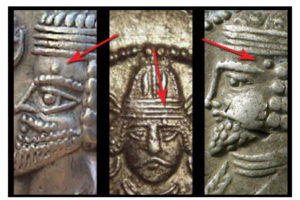An Important New Work on Armenian Coinage. It has been almost 30 years since a well researched and organized book on the early Armenian kings has been published. This is by far the most complete to date. Frank Kovacs has created a numismatic masterpiece. He has brought to light new, uncategorized kings in a clear and evident way. Certainly there is always room for speculation. However, using the finest examples and the most complete legends available, Frank has done his homework. This book belongs in every collector of Armenian coins and dare I say, in every Armenian home. For the cost of a good meal for two people at a restaurant, this book will bring years of knowledge into the hands of the Armenian numismatic detective community. As an example:
The above coin, previously attributed to the Persian Satrap, Pharnabazos, now attributed by Frank Kovacs, as the Persian Satrap of Armenia, Orontes. Many believe he was also of the Armenian bloodline of the ancient Orontes dynasty. This is the oldest and rarest Armenian gold coin in existence with about 13 coins known. This is the first and possibly the only Armenian gold coin spanning 1600 years! Not until the gold coins of King Levon I in 1199 AD, do we have an official Armenian gold coin. There is much, much more.
Did you know the Roman Emperor Nero chose the king of Armenia? He was the great grandson of Herod the Great of Jesus time. There is much more to share.
The book is available from ANASociety – $85 -plus shipping quantities are limited.
We are grateful to CNG coins — wwwcngcoins.com for producing and selling the book. Here is there press release:
Kovacs, Frank L., Armenian Coinage in the Classical Period [Classical Numismatic Studies No. 10]. 2016. Hardbound with dust jacket. 142 total pp., consisting of 25 pages of introductory material, 57 pages of coin catalog listings, and 34 plates of photographed coins. (GR356) $85
The need for a revised and updated reference for Armenian coins of the classical period has been evident for many years. Publication has lagged, and with it, the discovery of numerous previously unknown coins while long-standing misattributions have hampered the best efforts of researchers in the field of Armenian numismatics. Armenian Coinage in the Classical Period attempts to address these problems and to present the ancient coins of Armenia as reliable source documents.
Building on the earlier work of Armenian numismatists Bedoukian, Nercessian, and Mousheghian and Depeyrot, Armenian Coinage in the Classical Period begins with the earliest known issues of Samos, after circa 275 BC, through the reign of Tiridates II, to circa AD 252, and includes all territories ruled by Armenian monarchs, or by any king or client king who ruled any territory called “Armenia.” Armenian coins issued under Seleucid, Parthian, or Roman domination are listed as well as contemporaneous pseudo-autonomous issues. This latter category needs much additional study and the few entries herein make no pretense to completeness.
Although conquered and briefly held by Tigranes the Great, the coinage of the Kingdom of Cappadocia is not included here. Its coins have been extensively discussed and catalogued most recently by A. Simonetta (CCKR). On several occasions Cappadocian kings controlled parts of Armenia; these incidents are mentioned in the text, and examples of their Cappadocian coins are provided in Appendix B.
The specific improvements to the corpus offered in Armenian Coinage in the Classical Period include the attribution or re-attribution of coins to kings and queens to whom no coins were previously assigned, the identification of new dating eras, the identification of new mints, and the removal of non-Armenian coins, fakes, and fantasies from the corpus. While some re-attributions and identifications are conjectural, and will, no doubt, be modified as newly discovered examples dictate, it is hoped that Armenian Coinage in the Classical Period will represent a substantial advance in presenting the basic, original source documents of an important eastern kingdom of the classical period, and will allow historians to better reconstruct the historical record.
Published by CNG. Available through the ANASociety
We will confirm postage and handling upon receipt of order and confirmation of shipping method.


